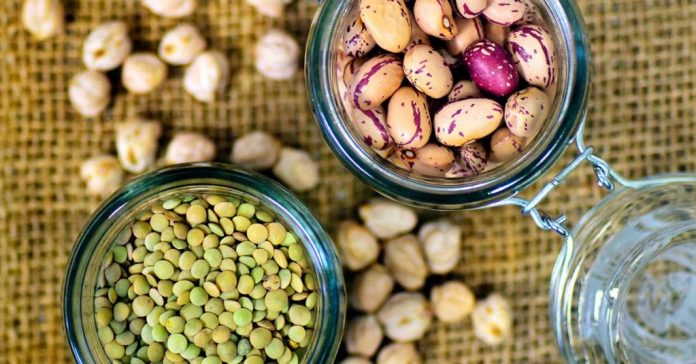
Vegetarian and vegan diets are the most ethical diets possible. They are also the most environmentally friendly choices a human could possibly make. But there is a lot of misinformation and ignorance surrounding vegan and vegetarian diets, especially when it comes to protein consumption.
For vegetarians, and vegans especially, there is an ongoing concern for protein. How much protein should vegans and vegetarians be eating? Surprisingly, this question is far less important than other protein-related questions. The questions vegans and vegetarians need to be concerned about is “Am I getting enough absorbable forms of protein with a complete amino acid profiles?”.
If you are a vegetarian or a vegan, this may be the most important and helpful article you will ever read and may be the difference between you failing or succeeding on a plant-based diet. Let’s take a look at the issue of protein, the importance of amino acids, and why this information is absolutely crucial to our health and well-being.
What are amino acids, and why do they matter?
All earthly terrestrial life depends on amino acids and their derivatives for form and function. While DNA contains the code of life, it is amino acids that express the code. Without amino acids, life – especially complex life – would not exist as we know it.
The tens of thousands of proteins of the human body are composed of 20 amino acids in various sequences and combinations. Amino acids can be considered like Lego blocks with various arms and extensions. From these 20 small simple building blocks, massive proteins are made that can have hundreds or thousands of building blocks connected together in an almost endless variety of combinations. These proteins give structure such as collagen and elastin in the skin and alpha-keratin in hair.
The biggest misunderstanding is that amino acids only serve the purpose of building muscle. Enzymes are proteins that serve as catalysts to make chemical reactions occur that would otherwise be impossible or too slow. Other proteins are involved in protection such as antibodies that find and clear foreign invaders and toxins. Information transfer in the brain and between cells occurs through protein receptors on the surface of cells. From amino acids, proteins are built that provide form and function to all of life.

Amino acids are also used at a basic level of body chemistry. Some amino acids can be converted to sugar in the form of glucose, as a reserve way to get glucose especially for the brain. Some are convertible to energy through the pathways that are otherwise used for fat. Perhaps most importantly, much of the communication in the brain and throughout the body is through amino acids that have been converted to small molecule messengers.
Without amino acids, you literally cannot experience happiness

Serotonin, the neurotransmitter and the chemical that allows us to experience happiness, is derived from the amino acid L-tryptophan. Dopamine, the “falling in love” molecule that gives a deep sense of well-being, is made from the amino acid L-tyrosine. The chemicals of love and happiness require adequate amounts of amino acids to be produced in the body.
Thyroid hormone that regulates production of cellular energy is also derived from L-tyrosine. The amino acid DL-phenylalanine safely intensifies activity of feel good endorphins, while also controlling appetite, and serving as a source of making additional L-tyrosine if needed. Providing amino acids in sufficient amounts is required for optimum function of the nervous system and cell-to-cell communication from head to toe.
In between single amino acids and the massive molecules that are proteins are structures known as peptides. If two amino acids are connected together this is called a di-peptide. The prefix “di” means two and peptide refers to any molecule in which two or more amino acids are bonded to each other. A tri-peptide is 3 amino acids that are strung together. A representative tri-peptide is L-glutathione, which is the body’s most powerful, abundant and important intracellular anti-oxidant.
If there are a few amino acids joined together, this is called an oligo-peptide (oligo means “a small number”), or simply a peptide. Above 10 amino acids connected together, the larger molecules are called poly-peptides (poly meaning “many”). Proteins are polypeptides, usually with 50-2000 amino acids joined together. The number and range of potential combinations of amino acids is nearly infinite. This gives form, function, signaling information, complexity evolution and integration to living form.
But don’t plants contain amino acids too?
Yes, but do they contain all of them, and do they contain enough? Let’s take a look at the amino acid break down for 1 cup of egg whites (243 grams) versus 10 ounces of spinach (284 grams) which is thought of to be a protein-rich vegetable.
Below is a chart of the amino acid breakdown for 243 grams of egg whites:

Below is a chart for 284 grams of spinach:
As you can see, the egg whites have about 4-5 times the amount of amino acids of spinach gram per gram. You would need to eat 5 bags of spinach to get the amino acid content of just a single cup of egg whites, and that doesn’t even take into account absorbability and digestion issues (which we will look at in a little bit). Contrary to what some vegans and vegetarians say, fruits and vegetables simply don’t cut it due to their incomplete amino acid profiles and inadequate amounts of amino acids.
Vegan-friendly complimentary proteins

This is why it is so important if you are a vegan or vegetarian to eat complimentary protein dishes every single day, such as soybeans or tofu with rice, or legumes with grains, as a way to cover your amino acid bases. Some vegans think you can just eat a bunch of fruits and vegetables only, when in reality beans, grains, and nuts or seeds are absolutely necessary on a daily basis. Soy is actually a complete protein containing all of the essential amino acids and should be eaten on a daily basis, along with other foods like hemp seeds, buckwheat, and quinoa. Here is a list of vegan-friendly dishes that contain complimentary proteins.
For example, corn protein has a low lysine content, an amino acid which is especially critical for normal immune function. If a person ate only corn, they would suffer protein deficiency even if their total protein intake was large. The balance is restored by consuming an L-lysine rich vegetable such as beans. The two together complement each other so that the lysine deficiency is overcome and all the amino acids will be present in adequate amounts.
There is also a strange concern within the community to avoid protein and eat a low protein diet as a vegan or vegetarian. If you are a vegan or a vegetarian, you need the proper amount of protein along with complete amino acid profiles. And remember, this is not a matter of just building muscle. Amino acids are necessary for basic cellular function and play many crucial roles in the body.
Amino acid deficiency
While we get amino acids largely from proteins in our diet, protein sources differ widely in their ability to provide all the amino acids in adequate supply. Consider that you are building a dam to contain water and it is only useful unless it is free of holes. There are 20 different bricks that have to be present in specific places in precise amounts. A deficiency of any of the bricks stops construction of the entire dam until the missing bricks are provided.
Deficiencies of amino acids are bad. There are two main types. The first type is simply not ingesting enough of them. Structures don’t get built. The integrity of body systems suffer. Skin, hair, muscles, mood, immune system, strength, and vitality go down the drain. Getting enough happens primarily through ingesting the minimum daily protein requirement. This is .8 grams of protein per kilogram of body weight, or approximately .4 grams per pound of body weight. For a person weighing 130 – 180 pounds, the basic requirement will be about 50-70 grams of protein daily. For elite athletes or body builders the required amount to build and maintain muscle mass may be double this amount.
The other type of deficiency is consuming proteins that are incomplete. This means that the protein is lacking the presence of one or more amino acids in an adequate amount. Construction in the body slows down and even stops when one of the types of bricks has run out of supply.
Incomplete proteins are the vexation of vegans and vegetarians. Whereas meat, dairy, and egg proteins are virtually always complete, most plant-based proteins are lacking in one or more amino acids. One could eat a mountain of an incomplete protein and requirements would fail to be met, which is why the protein issues is more than one of just counting how many grams you are consuming.
Being a healthy vegan or strict vegetarian thus requires much knowledge and attention to detail. It is very easy to slip into protein deficiency which can be systemically weakening to the body. This is so due to yet another obstacle facing the vegan lifestyle, captured in the initials NNU.
Net nitrogen utilization – the absorbability problem

Net Nitrogen Utilization, or NNU, refers to the number of grams of new proteins that are actually built in the body for each 100 grams of a protein source ingested. For meat and dairy proteins, such as whey protein, the NNU is 8-10%. This means that for every 100 grams of protein ingested, 8-10 grams of new proteins are built throughout the body systems. Vegetable proteins fare poorly by comparison, with an NNU of only 4-5%, and that is ONLY if complementary or complete. That means that at least double the vegetable protein needs to be eaten just to meet the minimum requirements.
Failure to consume complementary or complete vegetarian proteins in adequate amounts can result in a dwindling spiral of absorptive insufficiency. One of the main reasons that NNU is so low even for meat or dairy proteins is that a complex protein with hundreds or thousands of amino acids strung together must be broken down all the way to individual amino acids for the body to use them. If protein intake is insufficient, or the proteins are incomplete, the body will not get enough amino acids to make new proteins.
This is especially critical in the stomach and intestinal lining where specific enzymes are needed to chop giant proteins progressively all the way to single building blocks. Making these enzymes requires amino acids. If these are depleted, enzyme production is impaired and protein digestion itself can become compromised. Enzymes require amino acids, and plant proteins in particular require extra enzyme power because the proteins are encased in fiber.
Every wonder why cows have four stomachs? It’s because they graze all day and it requires extra digestive power to break down plant fibers to get at the proteins, and then to break down those plant proteins into individual amino acids so they can be used throughout the body.
If proteins are only broken down into peptides and not all the way to amino acids, the peptides can be absorbed and create an immune reaction in the body. This inflammatory action can result in leaky gut syndrome that further weeps and wastes proteins into the gut. Even worse, this allows larger peptide fragments to be absorbed and cause systemic allergic and inflammatory phenomena. This vicious spiral can escalate to widespread food intolerances and significant physical incapacity.
How to deal with the problem of amino acids and protein digestion

Digestive enzymes can be taken, but the other strategy, beneficial even with healthy gut function, is the use of free amino acids. These are pure individual amino acids that are already reduced in size to the building block state and don’t need to be broken down. They require no further digestion and are rapidly absorbed from the upper intestinal tract.
This overcomes the limitations of having all the digestive enzymes required in the right order and amounts, and erases any concern about proper amino acid intake. This provides amino acids that go directly into the intestinal lining to regenerate native enzymes and into the bloodstream for general vital protein production throughout the body.
The NNU of free amino acids is on the order of 90% or more. Consuming free amino acids is the most efficient way possible to meet daily requirements for building and maintaining optimum protein levels. For perspective, 8 ounces of meat (227 grams) contains about 60 grams of protein. Ingesting only 6 grams of free amino acids can equal or exceed the protein building value of half a pound of steak. The will also equal or exceed the value of consuming over 2 pounds of tofu or other soy protein.
Amino acids can be consumed individually and each has specific benefits for supporting the healthy structure and function of organs and systems. For greatest general benefits an amino acid formula will provide a full spectrum of amino acids in an optimum balance for total protein needs.
Free amino acid supplementation

A full spectrum amino acid supplement called Complete Aminos, was subjected to a controlled clinical trial. The study group was persons with weakened heart function, with 30 in the treated group and 20 in the untreated control group.
After one month the group taking the active amino acid formula at 2 grams (3 capsules) 3 times per day had a statistically significant average 25% enhancement of cardiac function. The control group had a 10% reduction of heart function which was not statistically significant.
To assess whether general protein function was affected, blood tests of systemic collagen production were done. Whereas the control group showed no change in production, the group taking the enhanced amino acids showed an 80% increase in collagen production by the 10th day and an over 100% increase in production by the 30th day compared to the control group. The increased collagen production was statistically significant and suggested that general bodily protein production was enhanced.
This study was published in the journal “Clinical Gerontology” (Volume 17, Number 9-10, Pages 45-48). The results form the basis of granted US patent 8,404,733: “Laser Enhanced Amino Acid Blend and Use of Same to Regenerate Active Myocardial Tissue”.
The formula known as Complete Aminos has the following:
- A full spectrum of 20 amino acids
- Modeled on optimum balances for each amino acid
- In vitro observations indicate reducing potential pro-inflammatory effects
- Clinical study shows specific and general systemic tissue benefit
- Study with athletes shows up to 30% increase in core strength for elite athletes and 85-100% increase in core strength for non-elite athletes after only 1-2 months if combined with intensive training
For building and sustaining all the vital proteins of the body, either supporting digestion with enzymes, or supplying free amino acids, or both, will offer advantages from head to toe. For vegetarians and vegans who risk protein deficiency, supplementing either or both offers a supportive edge for greater health. This is also great for non-vegetarians who struggle with protein absorption or leaky gut.
Environmentally and spiritually, there is nothing more pure and necessary than adopting a vegetarian or vegan diet. But if you are under eating, scared of protein, or not covering all of your amino acid bases each and every day, you could be doing more harm to yourself than good long term.














